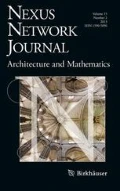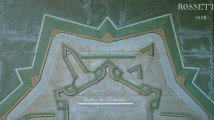Abstract
After studying the unpublished sketches of the Spanish artist Pablo Palazuelo, this essay proposes the existence of geometric patterns that order his designs. To illustrate the proposal, this paper selects three representative projects by Palazuelo that attempt to demonstrate the presence of a working process related to a mathematical substrate. Specifically, the use of an irregular tiling is proposed for the creation of the following architectural elements: the scenery for a composition by Kandinsky (1950–1954), and the plan for a hotel on Princesa Street, Madrid, (1961). This study also examines the use of regular tessellations in the design of the ceilings of the Huarte Residence in Madrid, (1965). The treatises by Bourgoin and Ghyka have been selected from the library of Palazuelo as the primary theoretical bases of this study. This methodology constitutes a line of further research to analyze different architectural projects.


Photo: Author

Image: author








Similar content being viewed by others
Notes
Pablo Palazuelo (Madrid, 1915–2007), a painter, sculptor and architect in pectore, studied architecture at the University of Madrid and the University of Oxford (1933–1936), studies that he was not able to complete due to the outbreak of the Spanish Civil War. Later, he decided to concentrate his energies on painting, moving to Paris, where he developed a fruitful artistic career linked to the Maeght Gallery. After his return to Spain, he endowed his work with the third dimension through his sculptural production. His designs also generated architectural works in collaboration with other architects. He was one of the most important abstract Spanish artists of the second half of the twentieth century. His work is exhibited in major museums; he received the Kandinsky Prize (1952), the Carnegie Prize (1958), the Gold Medal of the Fine Arts (1982), the National Prize of Plastic Arts (1999), and the Velázquez Prize (2004). Source: Fundación Pablo Palazuelo.
Since 2007, together with María Teresa Raventós, I have been preparing the catalogue of the archives of Palazuelo, comprising works, writings and books of his personal library conserved in the Fundación Pablo Palazuelo.
Jules Bourgoin (Join, 1838—Saint-Julien-du-Sault, 1907) was a French architect, professor of history and the theory of ornament at the National School of Fine Arts in Paris, and illustrator. He devoted his research mainly to theories of Arabic, Greek and Chinese ornament, as well as their correspondences to mathematics and geometry. His main publications are: Les Arts arabes (1867) with a prologue by Viollet-le-Duc, Théorie de l’ornement (1873), Les Éléments de l’art arabe (1879), Grammaire élémentaire de l’ornement (1880), Études architectoniques et graphiques (1901), and La Graphique (1905).
Matila Ghyka (Iáshi, 1881—London, 1965), was a Romanian mathematician, historian, philosopher, diplomat. He attended the High School of Electricity in Paris and doctored at the Faculty of Law of Université Libre de Bruxelles. He was a visiting professor of aesthetics in the United States, at the University of Southern California and at the Mary Washington College, Virginia. His main publications, found in the library of Palazuelo, are: Esthétique des proportions dans la nature et dans les arts (1927), Le nombre d’or. Rites et rythmes pythagoriciens dans le développement de la civilisation occidentale (1931), The Geometry of Art and Life (1946), Philosophie et Mystique du nombre (1952).
References
Bonner, Jay. 2017. Islamic Geometric Patterns: Their Historical Development and Traditional Methods of Construction. NY: Springer.
Bourgoin, Jules. 1879. Les éléments de l’art arabe. Le trait des entrelacs. Paris: Librairie de Firmin-Didot et Cie.
Broug, Eric. 2008. Islamic Geometric Patterns. London: Thames and Hudson.
Calvo Serraller, Francisco. 1985. España. Medio siglo de arte de vanguardia, 1939–1985. Madrid: Fundación Santillana, Ministerio de Cultura.
Critchlow, Keith. 1976. Islamic Patterns. An Analytical and Cosmological Approach. London: Thames and Hudson Ltd.
El-Said, Issam and Ayşe Parman. 1976. Geometric Concepts in Islamic Art. London: World of Islam Festival Publishing Company Ltd.
Esteban, Claude and Pablo Palazuelo. 1980. Palazuelo. Barcelona: Maeght.
Ghyka, Matila. 1946. The Geometry of Art and Life. New York: Sheed & Ward.
Morrison, Philip. 1981. On Broken Symmetries. In: On Aesthetics in Science, ed. Judith Wechsler, 55-70. Cambridge: The MIT Press.
Nasr, Seyyed Hossein. 1964. An Introduction to Islamic Cosmological Doctrines. Cambridge: Harvard University Press.
Palazuelo, Pablo. 1995. Geometría y Visión. Una conversación con Kevin Power. Granada: Diputación Provincial de Granada.
Palazuelo, Pablo. 1998. Pablo Palazuelo. Escritos. Conversaciones. Murcia: COAATM.
Palazuelo, Pablo. 1999. Pablo Palazuelo. Esculturas, dibujos y gouaches 1993–1998. Madrid: Museo Casa de la Moneda.
Palazuelo, Pablo. 2018. Geometría docente. Cursos impartidos en el Círculo de Bellas Artes. Madrid: Círculo de Bellas Artes.
Papert, Seymour A. 1981. The Mathematical Unconscious. In: On Aesthetics in Science, ed. Judith Wechsler, 105-119. Cambridge: The MIT Press.
Prieto y Vives, Antonio. 1977. El Arte de la Lacería. Madrid: Colegio de Ingenieros de Caminos, Canales y Puertos.
Vickers, Geoffrey. 1981. Rationality and Intuition. In: On Aesthetics in Science, ed. Judith Wechsler, 143-164. Cambridge: The MIT Press.
Acknowledgements
I would like to acknowledge the Fundación Pablo Palazuelo (FPP) (https://www.fundacionpablopalazuelo.es/), for allowing me to undertake this research work and to reproduce the documents that illustrate the present writing.
Author information
Authors and Affiliations
Corresponding author
Additional information
Publisher's Note
Springer Nature remains neutral with regard to jurisdictional claims in published maps and institutional affiliations.
About this article
Cite this article
Sotelo Calvillo, G. Tessellations in the Architecture of Pablo Palazuelo. Nexus Netw J 22, 349–368 (2020). https://doi.org/10.1007/s00004-019-00463-2
Published:
Issue Date:
DOI: https://doi.org/10.1007/s00004-019-00463-2




